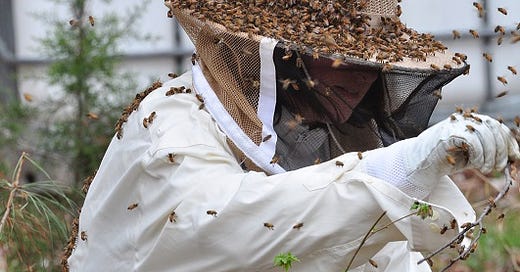7 things I look for when I split a hive
Splitting a hive only has the potential for success at different times of the year, and it depends on the health of the hive too.
Splitting a honey bee hive could put the colony in a precarious situation, but it could also set them up for success. While there are thousands, and sometimes tens of thousands, of honey bees in each colony—the honey bee colony itself is recognized as a superorganism. Just as any organism in the wild, its goal is to survive and populate. The spring season kicks off swarm season, and a colony ready to swarm or that has swarmed is generally a sign of health. The bees had everything they needed and felt confident enough to bid their queen farewell, and she flies off and takes half the colony with her. (ICYMI check out my earlier post about bee removals, which are the result of swarms taking up residence in homes.)
The downside of a swarm is that it’s essentially hundreds of dollars flying away. Not only is this a loss of future honey, beeswax, pollen, or propolis harvests (depending on which products from the hive one manages), but it’s the loss of a healthy, laying queen. For someone who’s been beekeeping awhile (I’ll raise my hand!) and has healthy hives that have bred locally generation after generation, then it’s also the loss of great genetics that are adapted specifically to the area. You can’t really put a price on that.
To prevent hundreds of dollars flying away, I closely monitor the hives and the weather at this time of the year to scout which colonies need to be split in order to prevent a swarm. Here’s what I look for before making a split:
Drone brood. Drone honey bees are the male bees. Every time the queen lays an egg, she decides whether it will be male or female. She only lays drones at certain times of the year. After a colony swarms, the remaining worker bees make a new queen and that virgin queen will need to mate within the first few days that she’s born (emerges). If there are no drones in the area, she won’t mate successfully and then the colony will fail. Seeing drones in a colony generally indicates that other colonies are likely producing drones, which means there’s greater potential for a virgin queen to successfully mate.
Queen cups. Colonies sometimes create queen cups along the bottom or sides of frames in anticipation of swarming someday. Those cups may stay there all season, or all year, without ever being used. They’re not too alarming unless you see an egg and/or royal jelly in it. If a queen cup has that, the colony is intending to swarm within a few days. If the queen cup is capped and sealed—known as a queen cell—then the colony likely already swarmed. At this time of the year, I look for an egg or royal jelly—if I see that then I 100% will split the colony as long as I find the queen.
Population. Behemoth colonies make me a little nervous. For one, if I do find a queen cup with larva in it, finding the queen in a giant colony is much more difficult and sometimes impossible. Two, managing hive boxes that are taller than me creates unique challenges that I’d rather avoid. Great populations are important though because having a huge colony means many workers to bring back resources. If timed right, a large colony during the nectar flow could bring in more honey. During a time of dearth, a large colony might fail because there are too many mouths to feed. Small colonies generally shouldn’t be split because you want to set the original and new colony up for success.
Time of year. See #1 drones and also consider that queens stop or slow laying in the winter. Splitting a hive late in the fall, or in the winter, means failure. It means a poorly mated queen or a queen who won’t have time to lay enough workers to keep her warm and fed through winter.
Food sources. Splitting a colony during a time of dearth means that you’ll need to provide supplemental feeding. Timing a split during a time of abundance helps the colony find the right nourishment to build their population.
Weather. A honey bee queen takes 16 days from egg to emergence. During hurricane season I’m not as quick to make a split. Queen bees mate in flight about 20’-to-30’ above the ground. Stormy weather isn’t mating weather.
Queen! You can’t make a split without finding the queen, so finding her is mandatory.
Ask other beekeepers what they look for when they make a split. Then ask them some more…
Surprise your local beekeeper with this question (and what to consider if you keep bees)
Speaking as a beekeeper, when non-beeks learn I’m a keeper, the most common questions they ask include: How often do you get stung? How many hives do you have? Can I buy some honey? How much honey do you get? How long have you kept bees? How are your bees? I hear they’re dying out.





